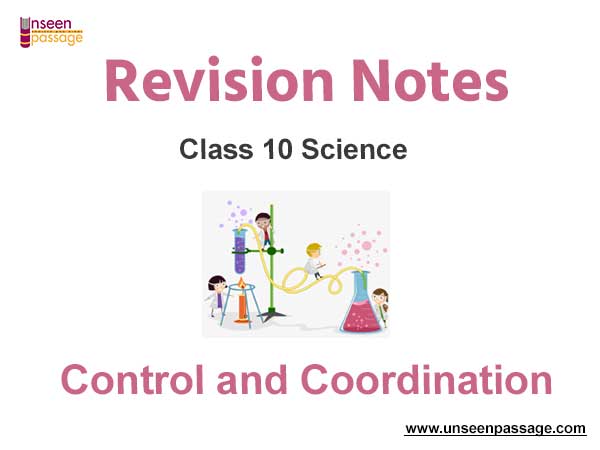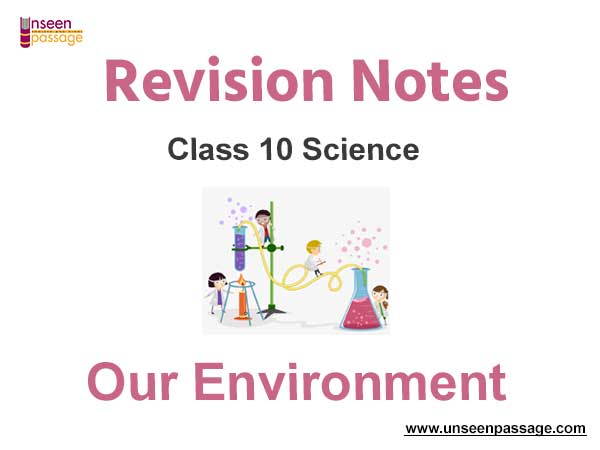Control and Coordination Notes for Class 10 Science
Following are Control and Coordination Notes for Class 10 Science. These revision notes have been prepared by expert teachers of Class 10 Science as per the latest NCERT, CBSE, KVS books released for the current academic year. Students should go through Chapter 7 Control and Coordination concepts and notes as these will help you to revise all important topics and help you to score more marks. We have provided Class 10 Science notes for all chapters in your book. You can access it all free and download Pdf.
Chapter 7 Control and Coordination Notes Class 10 Science
Stimulus: The change in the environment to which an organism respond and react is called stimulus.
Control & co-ordination in animals takes place by :
- Nervous system
- Hormonal system (Endocrine glands)
Parts of Nervous system:
- Brain
- Spinal cord
- Nerves
Neuron: Is the structural and functional unit of Nervous system
Parts of Neuron:
- Dendrites,
- Cell body
- Axon

Synapse: Junction between two adjacent nerves
Reflex action: spontaneous, involuntary and automatic response to a stimulus to protect us from harmful situations. E.g. On touching a hot objects unknowingly we instantly withdraw our hand.
Nervous system:
- Central Nervous System (CNS)
- Peripheral Nervous System (PNS)
(i) Autonomic Nervous System
(ii) Voluntary Nervous System
Brain
- Centre of coordination of all activities
- Thinking is involved
- Complex process

Fore brain Cerebrum :
(i) Main thinking and largest part of the brain.
(ii) It has 3 main areas.
1. Sensory area: to receive impulses from sense organs via Receptors
2. Motor area: control voluntary movements
3. Association areas: Reasoning, learning & intelligence.
Thalamus: It relays sensory information to the cerebrum.
Hypothalamus: It forms the link between Nervous system & Endocrine system
Mid brain: It connects fore brain and hind brain
Hind Brain: connects the fore brain and hind brain
Cerebellum: controls & coordinates muscular movements, maintaining body posture and equilibrium.
Pons: acts as a bridge between brain and spinal cord
Medulla Oblongata: Controls involuntary actions like blood pressure, salivation, vomiting etc.
Spinal cord: cylindrical or tubular structure is extending downwards from the medulla oblongata.
Protection of the brain & the spinal cord-
1. Bony outer covering: skull for the brain and vertebral column for the spinal cord.
2. Cerebrospinal fluid present in between the three membranes.
Hormones:
1. are chemical messenger secreted by endocrine glands
2. Are secreted in small amounts & may act in nearby places or distant places.
3. do not take part in the reaction & are destroyed immediately.
Important Endocrine glands, the hormone they secrete & their function
Coordination in plants: only chemical coordination is present in plants.
Tropic movements: the movements of plants in the direction of stimulus (positive) or away from it (negative) are called tropic movements. E.g. Phototropism, Geotropism, Chemotropism.
PLANT HORMONES(PHYTOHORMONES)
The four types of plant hormones responsible for control and coordination in plants are:
1. Auxins
2. Gibberellins
3. Cytokinins
4. Abscisic acid (ABA)
While auxins, gibberellins and cytokinins promote the growth of a plant, abscisic acid prevents or hampers the growth of a plant.
Auxins
Auxins hormone controls a plant response to light and gravity. It is made by the cells present at the tip of a stem and roots. This hormone moves the plant away from light and towards gravity. It speeds up the growth of stem and slows down the growth of roots.

This diagram explains the bending of a plant stem or shoot towards light by the action of ‘auxin hormone’.
Auxins promote cell enlargement, cell differentiation and fruit growth
Gibberellins
Gibberellins hormone works in the presence of auxin hormone and promotes cell enlargement and cell differentiation. It also promotes fruit growth, elongation of shoots and in breaking the dormancy in seeds and buds.
Cytokinins
This hormone promotes cells division in plants and breaks dormancy in seeds and buds. They also delay ageing in leaves and promotes the opening of stomata.
Abscisic acid
This hormone inhibits the growth of a plant. Therefore abscisic acid promotes dormancy in seeds and buds. It promotes closing of stomata, wilting and falling of leave and detachment of fruit and flower from the plant.
Important Endocrine glands, the hormone they secrete & their function




